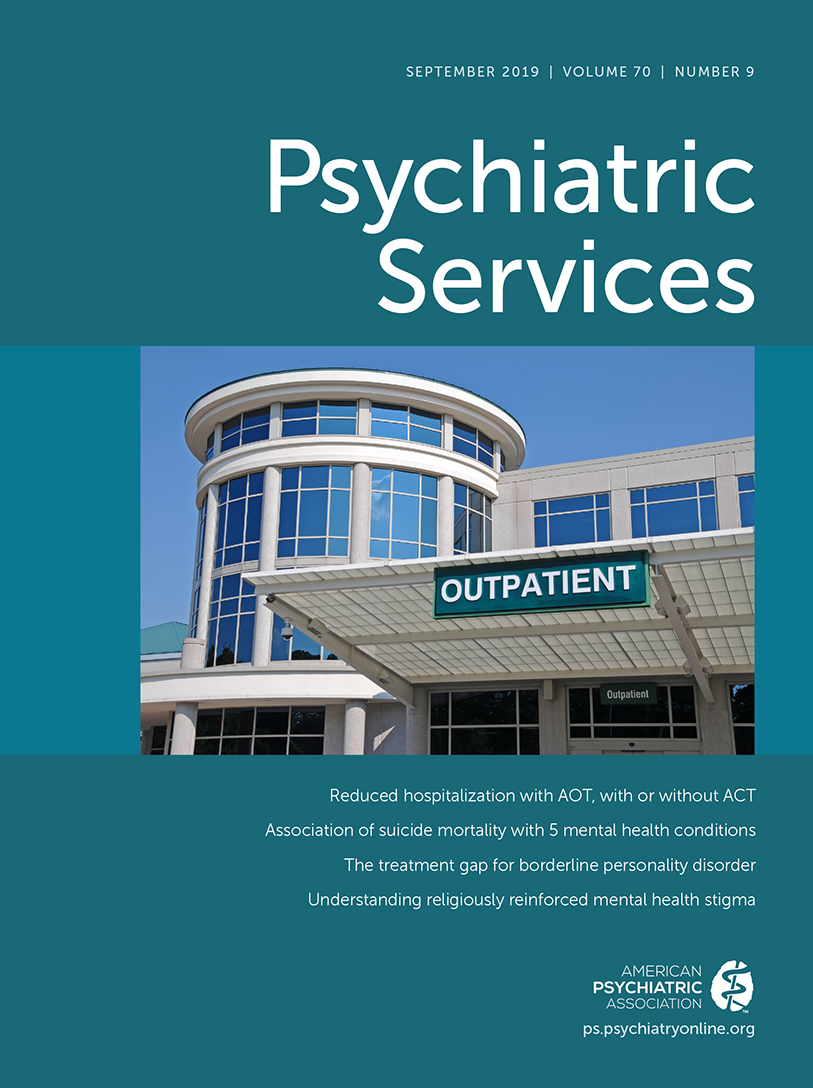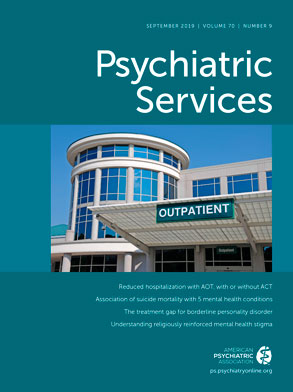The patients who are the most vulnerable to poor health outcomes are also the most likely to miss their health appointments. Missed appointments are known to correlate with poverty, underinsurance, low educational level, racial-ethnic minority status (
1–
3), and increased severity of psychiatric symptoms (
3,
4). Although clinic staff may interpret missed appointments as resistance to care (
5), patients with low socioeconomic status face significant barriers to keeping scheduled appointments. Housing instability, inconsistent telephone access, employment commitments, transportation difficulties, and child care responsibilities can all lead to poor utilization of a traditional clinic model (
1,
2). The end result is that many patients with the highest level of need are discharged by their providers and referred to other facilities, where they continue to miss appointments and face treatment termination in a cycle that has been called “musical clinics” (
6) because it does not end with stable treatment.
In psychiatry, walk-in policies have been used in some practices to accommodate patients who historically miss their appointments, while virtually eliminating prolonged appointment lag times (
2,
6,
7). However, despite their promising potential, walk-in clinics have not gained traction in psychiatry as a whole, and no standardized model for a psychiatry walk-in clinic has been rigorously studied (
7). We sought to develop a psychiatry walk-in model that would accommodate patients who historically missed appointments at least as well as a traditional scheduled appointment model and that would prove feasible to operate within a fee-for-service health system.
Methods
We opened a longitudinal urgent care psychiatry (LUCY) clinic as a weekly half-day session within an ambulatory psychiatry practice that serves adults in a tertiary-care hospital system. The psychiatry practice was staffed by seven attending psychiatrists during the 6-month study, corresponding to 2.5 full-time-equivalent (FTE) ambulatory positions. Twenty LUCY sessions were staffed by a psychiatrist who did not have other clinical time in the practice; the remaining seven sessions were staffed by practice psychiatrists. Practice psychiatrists had an option to close a regular half-day clinical session in exchange for staffing a LUCY session, which could have resulted in the deferral of up to seven scheduled intake appointments.
Through LUCY, any new or returning patient who had received outpatient care from another medical or surgical provider in our hospital system could access psychiatric care simply by coming to the clinic on a Wednesday afternoon and asking to be seen as a walk-in patient. However, a targeted advertising strategy was used to recruit patients with a high risk of missing scheduled appointments. Psychiatry triage staff screened referred patients for missed appointment risk according to an algorithm previously developed for a primary care–based psychiatry walk-in clinic (a no-show rate of 20% or higher) (
3) or a history of termination from ambulatory psychiatry services because of missed appointments. These patients were invited to the LUCY clinic. An invitation to the LUCY clinic could also be made if the referring provider or the patient expressed a need to be seen urgently before the next available scheduled appointment. This model was simultaneously promoted as a way for our hospital system’s on-call psychiatrists to refer a patient for a face-to-face visit if they could not accommodate the patient personally.
All invitations to participate in LUCY were screened by a licensed psychiatric social worker whose salary was covered by 0.05 FTE funding for this project. The social worker called all patients who had been referred to the LUCY practice on the basis of prior missed appointments, explained the clinical model to them, and invited them to the next clinical session until a maximum of 10 patients had been invited per week. The social worker would additionally review the electronic health records of patients referred to LUCY on the basis of urgency, and if fewer than 10 patients had been invited for the week, she would invite those patients to the next LUCY session in advance of their previously scheduled appointment with a new provider.
The complete clinic guidelines and policies are available in the online supplement. After checking in at reception, patients waited to see the psychiatrist on a first-come, first-served basis. If more patients arrived than could be accommodated by a single provider, other clinic providers with open slots because of missed appointments or late cancellations were asked to conduct a LUCY overflow visit if possible.
Most initial psychiatric evaluations lasted 30–40 minutes, but each visit was given as much time as needed, and the psychiatrist provided treatment, referral, or both at the time of the encounter. Patients might be asked to return to LUCY within a certain time frame or on an as-needed basis, but the specific psychiatrist providing care would not necessarily remain consistent between sessions. The psychiatrist who provided care in LUCY would personally handle any communications that immediately pertained to the visit (e.g., pharmacy calls for clarification about a prescription), but subsequent communications were handled by the on-call psychiatrist. Patients who did not return within the recommended time frame would not face penalties or termination but would not receive automatic medication refills.
We reviewed our hospital system’s electronic health record to track the number and type of clinical encounters and the demographic characteristics of patients who received encounters in both traditional care and the LUCY model from March 1 through August 31, 2018. We kept a manual log of all patients who were either invited to LUCY or received at least one LUCY encounter and compared this list with the electronic health record to ensure accuracy. This study was approved by our institutional review board.
We report percentages to describe categorical variables and means (±SD) to describe continuous variables. Statistical significance between means was determined by a chi-square analysis for binary categorical variables and by a two-tailed, unpaired t test for binary continuous variables. Odds ratios (ORs) and 95% confidence intervals (CIs) for accessing an initial psychiatry encounter through LUCY versus a scheduled appointment were calculated for demographic groups if a chi square or t test indicated statistical significance. A p value of ≤0.05 was considered statistically significant. We used Microsoft Excel 2016 for all calculations.
Results
During the study period, 72 of 143 (50%) patients invited to participate in LUCY received treatment; in addition, another 18 patients who were not invited received treatment. The LUCY provider submitted charges for 80 initial evaluation visits (800 per FTE) and 33 other encounters (330 per FTE). Six patients left without being seen: two were unable to wait, two were ineligible to receive care in the practice, and two did not specify a reason. Among those who left without being seen, three returned to LUCY at a later date and received care. Five visits were conducted by an overflow psychiatrist. Among the patients who received an initial evaluation in LUCY, 35 (44%) returned for at least one visit with a psychiatrist (in either LUCY or traditional care) within the following 3 months.
Table 1 compares the demographic characteristics of patients who received initial evaluations in LUCY versus traditional care. in a nonsignificant trend, a higher proportion of nonwhite patients accessed care through LUCY rather than through traditional care. Medicaid recipients were significantly more likely to access care through LUCY compared with patients with other insurance carriers (OR=1.89; 95% CI=1.10–3.24). Patients without a college degree were more likely than those with a college degree to access care through LUCY rather than traditional care (OR=1.86; 95% CI=1.04–3.32).
An average of 3.85 slot hours were filled per 4-hour LUCY session (range 0–8.5), yielding an efficiency of 96.3%. The traditional care practice submitted charges for 275 initial evaluations (112 per FTE) and 2,421 other encounters (982 per FTE) and used 91.5% of its appointment slots.
Discussion and Conclusions
This study demonstrates that ambulatory psychiatric care can be delivered without advance scheduling, and that eliminating appointments does not necessarily compromise productivity. The LUCY model may also offer a unique access point for the Medicaid population. Most of the patients who received care in LUCY were deliberately invited, and approximately half of the target population for this model was reached. Room for improvement remains. Some patients would prefer to wait for an appointment with a referred provider than spend long periods in a waiting room prior to a walk-in appointment, and the typical wait time of 30–120 minutes to be seen in LUCY was usually spent unproductively. In some cases, the social worker could be deployed to manage nonmedical needs during the wait, but the limited time allocated to the social worker role did not consistently allow for such endeavors. We believe that future iterations should dedicate 0.1–0.2 FTE to fund this role for the social worker.
This study was limited by its single location and limited number of participants and because its primary outcome of access to care was only an intermediate step toward treatment engagement. Our results show improvements in the timeliness, efficiency, and equitability of care delivery, which are all indicators of high quality in health care (
8). However, downstream outcomes would be better measures of effectiveness. Because we did not conduct a randomized clinical trial, we cannot account for confounding factors, including the likelihood that Medicaid recipients were disproportionately represented among those invited to LUCY.
Despite these limitations, the LUCY model can facilitate rapid access to ambulatory psychiatric care for a high volume of underserved patients relative to the clinical resources invested. The model is feasible to implement and can increase the volume of Medicaid recipients who access psychiatric care.

